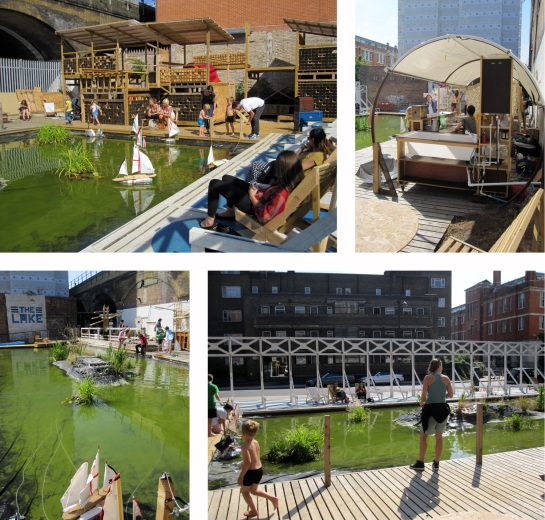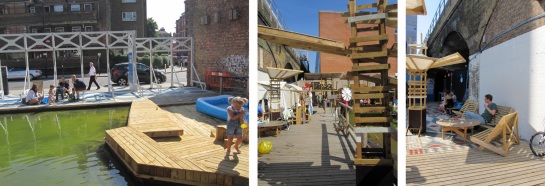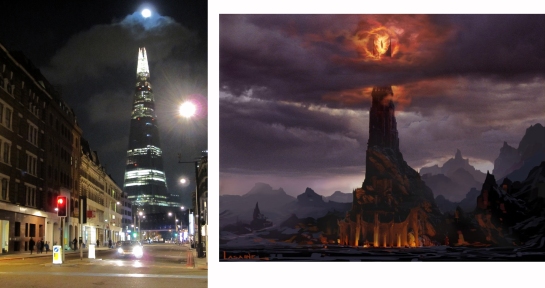Exyzt is a collective of multi-disciplinary professionals from a variety of fields such as film, graphic design, dj-ing, botany and more. It was initiated by five architects in 2003 and they have been experimenting with pop-up public spaces ever since. In the past they have created such places in France, the UK, Spain and other countries.
The Londoners might know them also from the Dalston Mill (2009) that was a rather unique architectural/art project that was built with the support of the Barbican in Dalston. It actually still exists (with some transformations) as a community garden. However their designated space where most of their experiments take place is located on Union street in Southwark on a plot of land right by the train arches. This is actually where last year’s project name came from: the ReUnion. That project was the first one that I visited and where I met one of the founders of the collective. We chatted for a while and as I mentioned in last year’s post (read it here) he explained how they always came back to that particular location. Basically it is a private plot of land that is owned by a friend of theirs who gives it to them for free. A building permission for temporary use is issued and Exyzt and whoever wants to volunteer, joins in to built each year’s project. They recycle most of the wood they use and they store and reuse furniture and other found or made objects as well.

top left pic : Boat race / top right pic : the cafe and shop / bottom right pic : view from the shop
I regret not asking whether there is actually a hierarchy in the design procedure or not. I suppose there must be some sort of creative team that proposes the initial idea but I am not sure how the details are negotiated. Still both of the projects that I have visited so far demonstrate a degree of creativity that seems quite spontaneous. I guess that the only way to find out how the collective works is by participating in the construction of one of its projects. Judging from Exyzt’s manifesto statement though, (published in their website see here) it seems that there is no single master-mind behind the creative procedure of each year’s public space.
A friend and I visited the Lake on a sunny day and we brought our lunch there. We entered through the gates which are the same with last year’s space, the ReUnion, but have been painted over with an interesting blue and white pattern. Later on browsing through Exyzt’s facebook page I realised that this pattern is in fact a copy of Copacabana‘s promenade, designed by Brazilian landscape architect Roberto Burle Marx. This is a humorous wink implying that this small public space is somehow similar to the beautiful beach in Rio de Janeiro. The entrance ramps, which I liked a lot since last year, when lifted up, become the gates/fence that enclose the Lake at night. They establish the transition between what is inside and what is outside, however more than anything else they open up the space to the street and random passer bys do not feel intimidated to cross them.
In the middle of the space there is a shallow pool that resembles a lake. A little island is placed in the middle of it but during my stay only a few visitors chose to go there because the floor of the lake looked quite slippery. Actually most children slipped and fell into the water but they seemed to enjoy themselves so much that ultimately the slippery-factor adds to the playful atmosphere. To the right of the lake there is a piece of pebbled dry land with an interesting wooded structure of a high-levelled deck for the placement of the visitors’ tents. Decks also surround the lake and on them are various sitting areas and the shop and the cafe. To the left of the lake is a series of smaller levels and a clear watered pool where children play as well.
I stayed at the Lake with my friend for a while to get a feel of the place. Observing the people, mostly parents and children in their swimsuits splashing around, it was obvious that everyone was enjoying the space a lot. The parents looked very pleased because their children seemed to be having a blast while the environment also felt quite safe and small enough for children to be constantly in sight.
Playful details, similar to the ones that I observed last year added a lot to the atmosphere of the place. For example the miniature sail boats that were attached to the decks that the children loved racing with or the crocodile made out of some sort of floating material wrapped in plastic. Spotting a dragonfly resting on one of the sails of the toy-boats proved that regardless of the fact that the lake is not real it does attract some local fauna.
The visit was pleasant and relaxing and I happily stayed there for a while enjoying the sun. Of course the children (and the grown-ups who felt young enough to splash around with them) got the best of this year’s project. Similar to last year it feels like the space is totally open to the public without any rules nor implying it is obligatorty to purchase something in order to feel welcome.
As far as I can see from the two projects that I have visited so far and also by reading the collective’s manifestos and statements this is what they are after. Experimenting with the design and the construction of the projects must be an adventurous and fulfilling process for the people who are involved in it. Additionally offering their creation to the public to use and enjoy as they please has an almost utopian element in its theoretical basis. Exyzt say that they dream of architecture being a shared experience that unfolds and develops when created but also during its use as well. It looks as if they attempt to bring architects down from their pedestals of superiority and patronisation of the user. In principle they are quite revolutionary. Regardless of the obvious political implications of such an endeavour, I believe they are orientated rather towards the experimentation of design that politics. They manage to produce temporary little havens where people coexist and are able to be spontaneous and creative. In some ways they keep alive the concept of utopia that we imagined as architecture students. It was mostly back then when we still hoped that design and beauty could instigate true change in people’s lives.
Unfortunately their projects are short-lived. They are little pockets of utopia in a society where whole communities are sacrificed every day for the sake of profit, through the greedy process of gentrification.
The Lake will remain open until the end of September. Visit their program of happenings here
talks on temporary public spaces tomorrow Thursday the 19th and and Thursday the 26th of September.
Exyzt’s facebook page here
Exyzt’s website here









